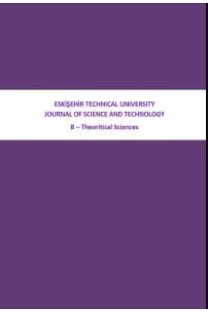FARKLI TİPTE ÜRETİLEN HARÇLARIN YARI-DEĞER KALINLIKLARININ TEORİK OLARAK İNCELENMESİ
Soğurulma katsayısı, yarı-değer kalınlık, kesirsel matematik
THEORETICAL INVESTIGATION OF HALF-VALUE THICKNESS OF MORTARS PRODUCED BY DIFFERENT TYPES
___
- [1] Leo WR. Techniques for Nuclear and Particle Physics Experiments. Berlin, Germany: Springer Verlag, 1994.
- [2] Yülek GG. Radyasyon Fiziği ve Radyasyondan Korunma. SEK yayınları:14, 1992.
- [3] Meckbach R, Jacob P, Paretzke HG. Shielding of gamma radiation by typical European houses. Nucl Instrum Methods Phys Res A 1987; 255: 160–164.
- [4] Alam, MN, Miah MMH, Chowdhury MI, Kamal M, Ghose S, Rumi R. Attenuation coefficients of soils and some building materials of Bangladesh in the energy range 276–1332 keV. Appl Radiat Isot 2001; 54: 973–976.
- [5] Akkurt I, Kilincarslan S, Basyigit C. The photon attenuation coefficients of barite, marble and limra. Ann. Nucl. Energy 2004; 31: 577–582.
- [6] Singh S, Kumar A, Devinder S, Kulwant ST, Mudahar GS. Barium-boratefly ash glasses: as radiation shielding materials. Nucl Instrum Methods Phys Res B 2008; 266: 140–146.
- [7] Salinas ICP, Conti CC, Lopes RT. Effective density and mass attenuation coefficient for building material in Brazil. Appl Radiat Isot 2006; 64: 13–18.
- [8] Awadallah MI, Imran MM. Experimental investigation of γ-ray attenuation in Jordanian building materials using HPGe-spectrometer. J Environ Radioactivity 2007; 94: 129–136.
- [9] Türkmen I, Özdemir Y, Kurudirek M, Demir F, Simsek Ö, Demirboğa R. Calculation of radiation attenuation coefficients in Portland cements mixed with silica fume, blast furnace slag and natural zeolite. Ann Nucl Energy 2008; 35: 1937–1943.
- [10] Medhat ME. Gamma-ray attenuation coefficients of some building materials available in Egypt, Annals of Nuclear Energy 2009; 36: 849–852.
- [11] Yılmaz E. Bazı İnşaat Malzemelerinde Gama Işını Soğurma Katsayısı ve Nötron Soğurma Tesir Kesitinin Belirlenmesi. Yüksek Lisans Tezi, Rize Üniversitesi, Rize, Türkiye, 2011.
- [12] Yılmaz E, Baltas H, Kırıs E, Ustabas I, Cevik U, El-Khayatt AM. Gamma ray and neutron shielding properties of some concrete materials. Annals of Nuclear Energy 2011; 38: 2204–2212.
- [13] Şen M, Çalık AE. Calculation of Half-Value Thickness for Aluminum Absorbers by Means of Fractional Calculus. Annals of Nuclear Energy 2014; 63: 46-50.
- [14] Şen M, Çalık AE, Ertik H. Determination of half-value thickness of aluminum foils for different beta sources by using fractional calculus. Nuclear Instruments and Methods in Physics Research Section B: Beam Interactions with Materials and Atoms 2014; 335: 78-84.
- [15] Şirin, H. Transport olayının istatistiksel mekanik yöntemlerle incelenmesi, Doktora Tezi, Ege Üniversitesi, İzm,r, Türkiye, 2011.
- [16] Oldham KB, Spainer J. The Fractional Calculus, San Diego, USA: Academic Press, 1974.
- [17] Miller KS, Ross B. An Introduction to the Fractional Calculus and Fractional Differential Equations. New York, USA: John Wiley and Sons Inc, 1993.
- [18] Carpinteri A, Mainardi F. Fractals and Fractional Calculus In Continuum Mechanics. Berlin, Germany: Springer Verlag, 1997.
- [19] Podlubny I. Fractional Differential Equations. San Diego, USA: Academic Press, 1999.
- [20] Çalık AE, Şirin H, Ertik H, Şen M. Analysis of charge variation in fractional order LC electrical circuit, Revista Mexicane de Fisica 2016; 62: 437-441.
- [21] Buyukkilic F, Bayrakdar Ok Z, Demirhan D. Investigation of the cumulative diminution process using the Fibonacci method and fractional calculus. Physica A Statistical Mechanics and Its Applications 2016; 444: 336-344.
- [22] Ertik H, Çalık AE, Şirin H, Şen M, Öder B. Investigation of electrical RC circuit within the framework of fractional calculus. Revista Mexicane de Fisica 2015; 61: 58-63.
- [23] Şirin H, Büyükkılıç F, Ertik H, Demirhan D. The effect of time fractality on the transition coefficients: Historical Stern-Gerlach experiment revisited. Chaos Solitions and Fractals 2011; 44: 1-3.
- [24] Şirin H, Büyükkılıç F, Ertik H, Demirhan D. The influence of fractality on the time evolution of the diffusion process. Physica A-Statistical Mechanics and Its Applications 2010; 389: 2007-2013.
- [25] Çalık, AE, Ertik H, Öder B, Şirin H. A fractional calculus approach to investigate the alpha decay processes International Journal of Modern Physics E 2013; 22:1350049.
- [26] Çalık AE, Şirin H, Ertik H, Öder B, Şen M. Half-lives of spherical proton emitters within the framework of fractional calculus. International Journal of Modern Physics E 2014; 23: 1450044.
- [27] Mainardi F, Gorenflo R. On Mittag-Leffler-type functions in fractional evolution processes. J Comput Appl Math 2000; 118: 283-299.
- [28] Gerward L, Guilbert N, Jensen KB, Levring H. X-ray absorption in matter: reengineering XCOM. Radiat Phys Chem 2001; 60: 23–24.
- [29] Gerward L, Guilbert N, Jensen KB, Levring H. WinXCom – a program for calculating X-ray attenuation coefficients. Radiat Phys Chem 2004, 71: 653–654.
- [30] Davisson CM, Evans DR. Gamma-ray absrption coefficients. Reviews of Madern Physics 1952; 24: 79-107.
- [31] Thümmel, H.W., 1974, Durchgang von Elektron und Betastrahlung Durch Materieschichten, Academie Verlag, Berlin.
- [32] Burek, R., and Chocyk, D., 1996, Basic aspects of the mass absorption coefficient of beta-particles, J. Radional. Nucl. Chem., 181-191.
- [33] Singh K, Singh H, Sharma V, Nathuram R, Khanna A, Kumar R, Bhatti SS, Sahota HS. Gamma-ray attenuation coefficients in bismuth borate glasses. Nuclear Instruments and Methods in Physics Research Section B 2002; 194: 1-6.
- [34] Krane SK. Introductory nuclear physics. New York, USA: John Wiley and Sons, 1988.
- [35] Gürler, O. and Yalçın, S., 2005, A practical method for calculation of mass-attenuation coefficients of beta particles, Ann. Nucl. Enegy, 1918-1925.
- ISSN: 2667-419X
- Yayın Aralığı: Yılda 2 Sayı
- Başlangıç: 2010
- Yayıncı: Eskişehir Teknik Üniversitesi
PLASTİK ATIKLARDAN KARBON NANOTÜP (CNT) ÜRETİMİ ÜZERİNE BİR DEĞERLENDİRME
Aysun ÖZKAN, Ece YAPICI, Zerrin GÜNKAYA, Müfide BANAR
Aysun ÖZKAN, Zerrin GÜNKAYA, Alp ÖZDEMİR, Müfide BANAR
(HCl)2(CH3OH)2(X)k (X= NH3 veya H2O) Kümelerinde Proton Dinamiğinin Teorik Olarak İncelenmesi
Kamran SAMET, Oğuz YILMAZ, Harun KOÇAK, Asghar SAFARİAN, Çetin KARATAŞ
UÇURTMA GRAFIN LAPLASYAN ÖZDEĞERLERİ ÜZERİNE
FARKLI TİPTE ÜRETİLEN HARÇLARIN YARI-DEĞER KALINLIKLARININ TEORİK OLARAK İNCELENMESİ
